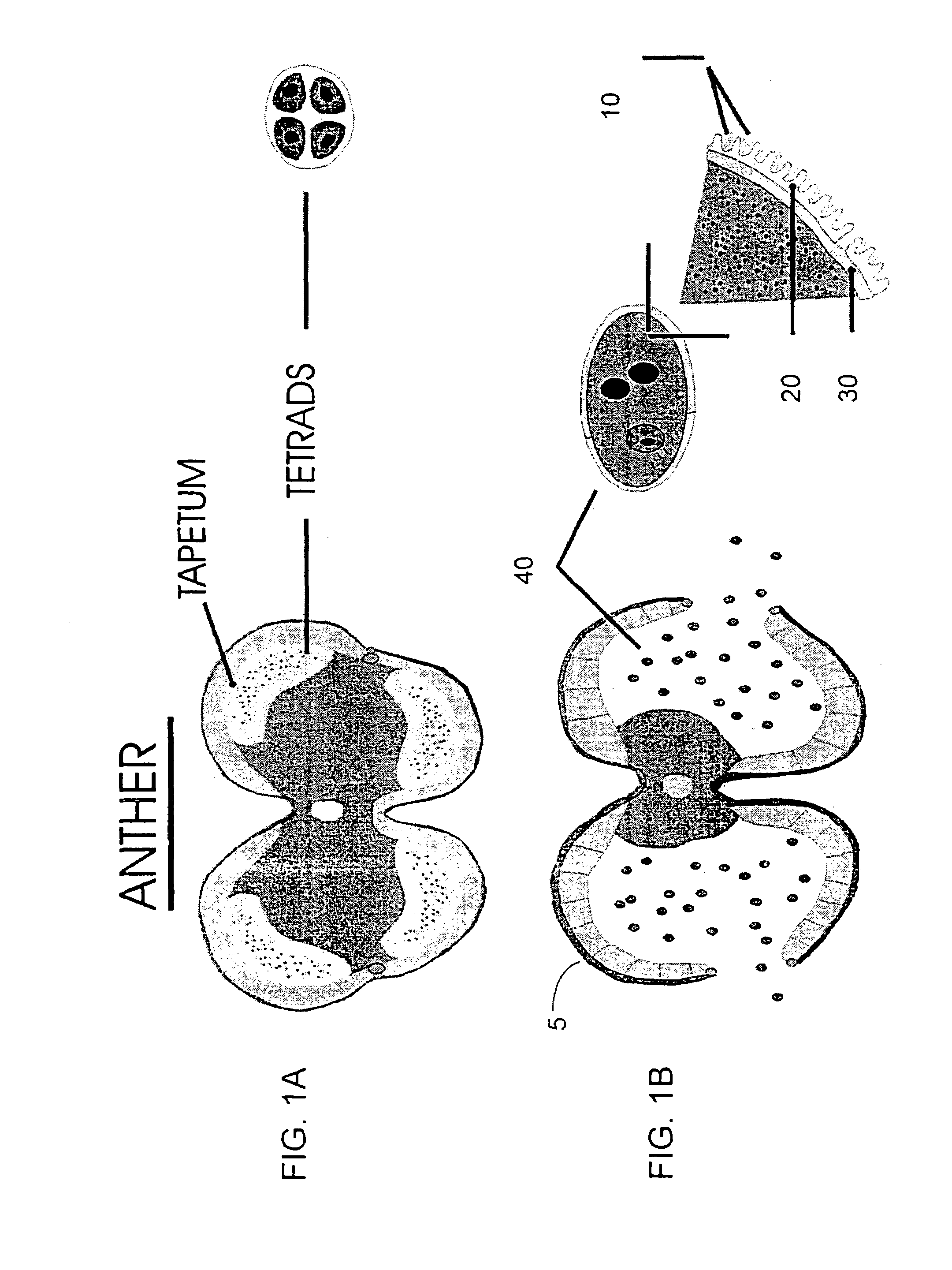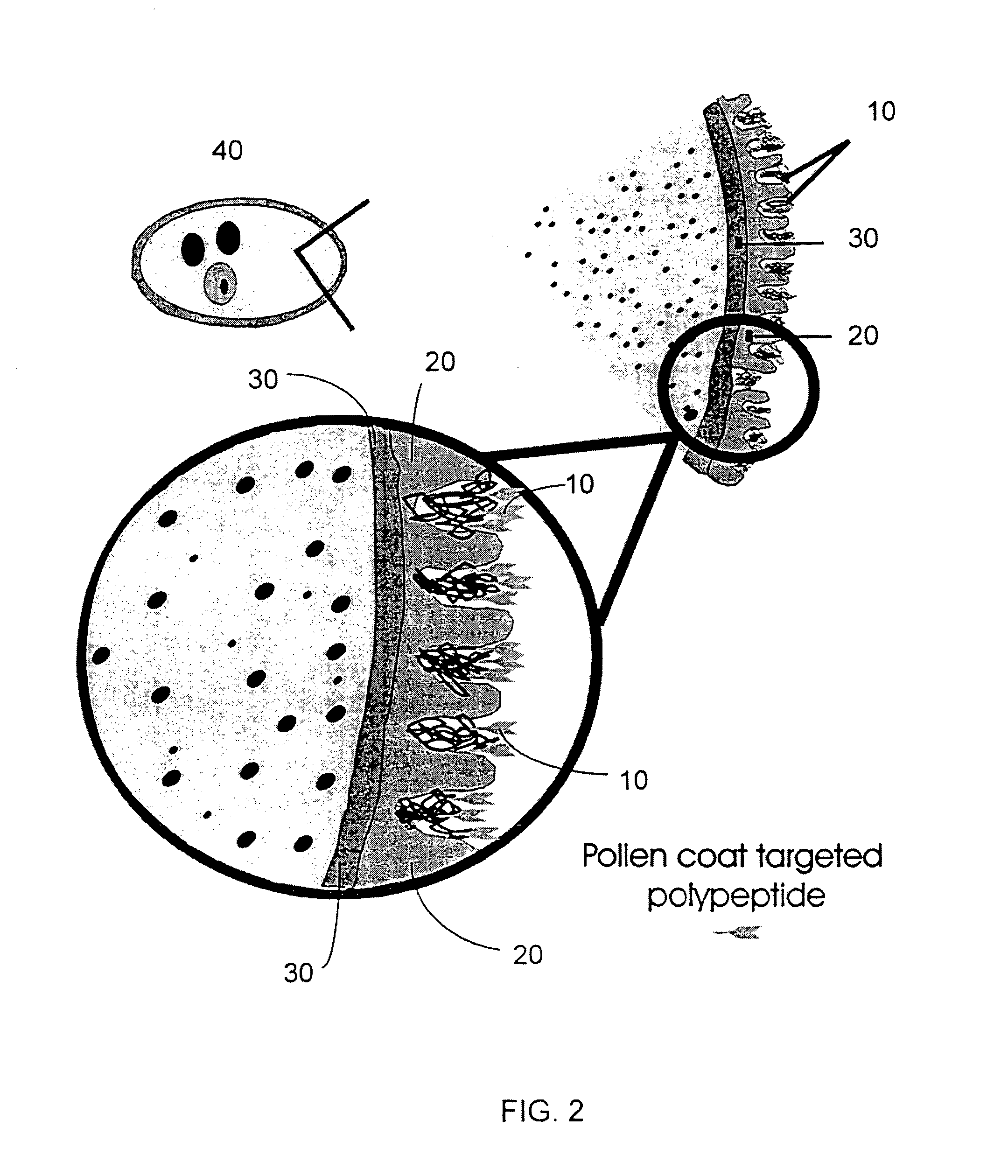Modification of pollen coat protein composition
- Summary
- Abstract
- Description
- Claims
- Application Information
AI Technical Summary
Benefits of technology
Problems solved by technology
Method used
Image
Examples
example 1
Isolation of Brassica napus Tapetal Oleosin-Like Gene
[0283]The cDNA clones Sta 41-2 and Sta 41-9 encoding tapetal oleosin-like proteins were isolated by differential screening of a flower cDNA library from Brassica napus (Robert, L. S., Gerster, J. L., Allard, S., Cass, L., Simmonds, J., Plant J. 6:927-933 (1994a)). The genomic clone Sta 41G(10) corresponding to cDNA clone Sta 41-9 was also isolated and the region upstream of the coding region shown to direct expression of a marker gene to the tapetum of transgenic Brassica napus plants (Hong, H. P., Ross, J. H. E., Gerster, J. L., Rigas, S., Datla, R. S. S., Hatzopoulos, P., Scoles, G., Keller, W., Murphy, D., Robert, L. S. Plant Mol Biol. 34:549-555 (1997b); U.S. patent application Ser. No. 08 / 595,937).
[0284]The genomic clone Sta 41G(10) was used for the construction of translational fusions to polypeptides of interest for targeting to the pollen coat. Other tapetal oleosin-like genes are also known (Ross, J. H. E., Murphy, D. J. ...
example 2
Fusion of a Brassica napus Tapetal Oleosin-Like Gene to the E. coli β-Glucuronidase Gene (TOG-1)
[0285]The Sta 41 G(10) Sac I subclone mp 101 is digested with Bam HI and Hind III releasing a fragment containing the 5′ upstream region of the tapetal oleosin-like gene and cloned into the Bam HI and Hind III sites of pBSK+ (Stratagene) to generate plasmid BH-1. Plasmid BH-1 is digested with Nde I, blunt ended with the Klenow fragment of DNA polymerase I and religated, effectively destroying the Nde I site and generating plasmid NB-6. Plasmid NB-6 is digested with Bgl II and Kpn 1 and used to replace the Bgl II and Kpn 1 fragment of mp 101. This effectively reconstructs the Sta 41 G(10) Sac I subclone (without the Nde I site within the promoter while preserving the Nde I site just upstream of the stop codon) and generates plasmid KB-1 (FIG. 4A). The Sta 41G(10) Sac I subclone is then cloned into pGEM7Z (Promega) to give plasmid SS-4. Plasmid SS-4 is digested with Nde I and ligated to the...
example 3
Fusion of the Brassica napus Tapetal Oleosin-Like Gene to the Sitophilus SCPc 1 Protease Gene (TOP-1)
[0287]A fragment of a cysteine protease from Sitophilus, from plasmid pSCPc1, was amplified by PCR (polymerase chain reaction). This fragment corresponds to the SCPc1 cDNA fragment cloned into pBSK-(Matsumoto, I., Emori, Y., Abe, K, Arai, S. J Biochem. 121: 464-476 (1997)). The oligonucleotide primers used in the PCR reaction are:
forward primer: P1: GCGCGGATCCTTGCCTGATACTGTTGAC (SEQ ID NO:20)
and reverse primer: P2: GCGCGAATTCAAGCTTCTAAACCAAAGGATAACTAGC (SEQ ID NO:21).
These primers permit the amplification of the mature cysteine protease coding sequence and introduce a Bam HI site (bold) at the 5′ end of the amplified DNA fragment and Eco RI and Hind III sites (bold) at the 3′ end.
[0288]The PCR fragment is digested with Bam HI and Hind III, and subcloned into the Bam HI and Hind III sites of pGEM 4Z (Promega) generating plasmid pSCPc1BH. Plasmid pSCPc1BH is digested with Bam HI and Hi...
PUM
| Property | Measurement | Unit |
|---|---|---|
| Fraction | aaaaa | aaaaa |
| Fraction | aaaaa | aaaaa |
| Fraction | aaaaa | aaaaa |
Abstract
Description
Claims
Application Information
 Login to View More
Login to View More - R&D
- Intellectual Property
- Life Sciences
- Materials
- Tech Scout
- Unparalleled Data Quality
- Higher Quality Content
- 60% Fewer Hallucinations
Browse by: Latest US Patents, China's latest patents, Technical Efficacy Thesaurus, Application Domain, Technology Topic, Popular Technical Reports.
© 2025 PatSnap. All rights reserved.Legal|Privacy policy|Modern Slavery Act Transparency Statement|Sitemap|About US| Contact US: help@patsnap.com



